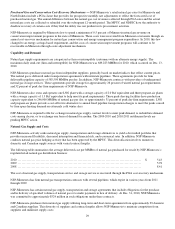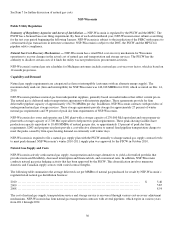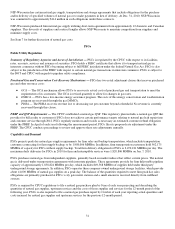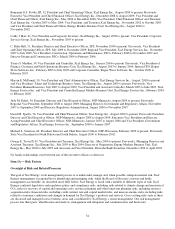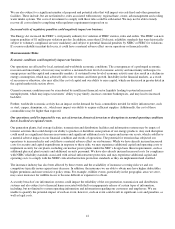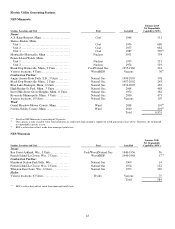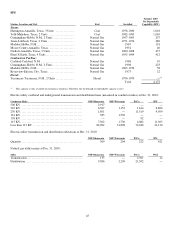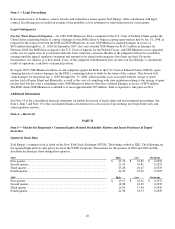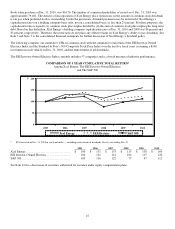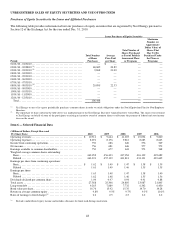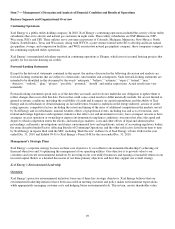Xcel Energy 2010 Annual Report Download - page 49
Download and view the complete annual report
Please find page 49 of the 2010 Xcel Energy annual report below. You can navigate through the pages in the report by either clicking on the pages listed below, or by using the keyword search tool below to find specific information within the annual report.39
Operational Risks
We are subject to commodity risks and other risks associated with energy markets and energy production.
We engage in wholesale sales and purchases of electric capacity, energy and energy-related products and are subject to market
supply and commodity price risk. Commodity price changes can affect the value of our commodity trading derivatives. We mark
certain derivatives to estimated fair market value on a daily basis (mark-to-market accounting), which may cause earnings
volatility. Actual settlements can vary significantly from these estimates, and significant changes from the assumptions
underlying our fair value estimates could cause significant earnings variability.
If we encounter market supply shortages or our suppliers are otherwise unable to meet their contractual obligations, we may be
unable to fulfill our contractual obligations to our retail, wholesale and other customers at previously authorized or anticipated
costs. Any such disruption, if significant, could cause us to seek alternative supply services at potentially higher costs or suffer
increased liability for unfulfilled contractual obligations. Any significantly higher energy or fuel costs relative to corresponding
sales commitments would have a negative impact on our cash flows and could potentially result in economic losses. Potential
market supply shortages may not be fully resolved through alternative supply sources and such interruptions may cause short-term
disruptions in our ability to provide electric and/or natural gas services to our customers. The impact of these cost and reliability
issues vary in magnitude for each operating subsidiary depending upon unique operating conditions such as generation fuels mix,
availability of water for cooling, availability of fuel transportation, electric generation capacity, transmission, etc.
Our subsidiary, NSP-Minnesota, is subject to the risks of nuclear generation.
NSP-Minnesota’s two nuclear stations, Prairie Island and Monticello, subject it to the risks of nuclear generation, which include:
● The risks associated with storage, handling and disposal of radioactive materials and the current lack of a long-term
disposal solution for radioactive materials;
● Limitations on the amounts and types of insurance commercially available to cover losses that might arise in connection
with nuclear operations; and
● Uncertainties with respect to the technological and financial aspects of decommissioning nuclear plants at the end of
licensed lives.
The NRC has authority to impose licensing and safety-related requirements for the operation of nuclear generation facilities. In
the event of non-compliance, the NRC has the authority to impose fines or shut down a unit, or both, depending upon its
assessment of the severity of the situation, until compliance is achieved. Revised NRC safety requirements could necessitate
substantial capital expenditures at NSP-Minnesota’s nuclear plants. In addition, the Institute for Nuclear Power Operations
reviews our nuclear operations and nuclear generation facilities. Compliance with the Institute for Nuclear Power Operations’
recommendations could result in substantial capital expenditures or a substantial increase in operating expenses.
If an incident did occur, it could have a material adverse effect on our results of operations or financial condition. Furthermore,
the non-compliance of other nuclear facilities operators with applicable regulations or the occurrence of a serious nuclear incident
at other facilities could result in increased regulation of the industry as a whole, which could then increase NSP-Minnesota’s
compliance costs and impact the results of operations of its facilities.
NSP-Wisconsin’s production and transmission system is operated on an integrated basis with NSP-Minnesota’s production and
transmission system, and NSP-Wisconsin may be subject to risks associated with NSP-Minnesota’s nuclear generation.
Our utility operations are subject to long-term planning risks.
On a periodic basis, or as needed, our utility operations file long-term resource plans with our regulators. These plans are based
on numerous assumptions over the relevant planning horizon such as: sales growth, economic activity, costs, regulatory
mechanisms, impact of technology on sales and production, customer response and continuation of the existing utility business
model. Given the uncertainty in these planning assumptions, there is a risk that the magnitude and timing of resource additions
and demand may not coincide. This could lead to under recovery of costs or insufficient resources to meet customer demand.


